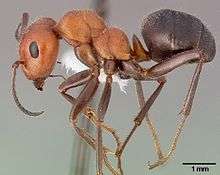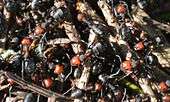Formica obscuripes
| Formica obscuripes | |
|---|---|
 | |
| F. obscuripes worker | |
| Scientific classification | |
| Kingdom: | Animalia |
| Phylum: | Arthropoda |
| Class: | Insecta |
| Order: | Hymenoptera |
| Family: | Formicidae |
| Genus: | Formica |
| Species: | F. obscuripes |
| Binomial name | |
| Formica obscuripes Forel, 1886 | |
Formica obscuripes (the western thatching ant) is a species of ant in the family Formicidae. It is native to North America. It produces large mounds covered by small pieces of plant material.[1] The number of adult workers per colony may be as high as 40,000.[2] F. obscuripes feeds upon a number of insect species, consumes nectar from homopterous insects they tend, and occasionally eats plant tissue.[1] In the Blue Mountains of Oregon, F. obscuripes has demonstrated the capacity for polydomy. A supercolony in a four-hectare study area near Lehman Hot Springs consisted of 210 active nests with an estimated population in excess of 56 million ants.[3]
Nests

F. obscuripes produce large dome-shaped mounds made up of varying material. The composition of the nest is largely based upon the immediate vegetation in the environment and is commonly referred to as "thatch". The size of these mounds is highly variable and dependent on the age and health of the colony. The average mound height ranges from 1 inch (1.5 cm) to 18 inches (45.7 cm)—although nests of larger heights are not uncommon—and can extend down to 4 feet (1.2 meters) in the ground. Chambers are present in both the thatched mound and the soil. The mounds are typically constructed in an open areas devoid of cover but are often formed around a structure. The condition of the thatched mound is in a constant state of change due to activities by the ants and environmental conditions.[4] When a colony possesses a suitable amount of adult workers, the ants proceed to chew off the bark at the base of plants growing on or nearby the mound. Formic acid is then ejected (sprayed) into the open layer eventually felling the plant.[5]
References
- 1 2 Heikkinen, M. W. (1999). "Negative effects of the western thatching ant (Formica obscuripes) on spiders (Araneae) inhabiting big sagebrush (Artemisia tridentata)". Great Basin Naturalist. 59 (4): 380–383.
- ↑ Capinera, J. L. (2008). Encyclopedia of Entomology, Volume 3. Springer. p. 4215. ISBN 978-1-4020-6242-1.
- ↑ McIver, J.; Torgersen, T.; Cimon, N. (1997). "A supercolony of the thatch ant Formica obscuripes Forel (Hymenoptera:Formicidae) from the Blue Mountains of Oregon". Northwest Science. 71 (1): 18–29.
- ↑ Weber, N (1935). "The Biology of the Thatching Ant, Formica rufa obscuripes Forel, in North Dakota. Ecological Monographs," (PDF).
- ↑ Cole, S.C. Jr. (1932). "The Thatching Ant, Formica obscuripes Forel Psyche Volume 39 (1932), Issue 1-2," (PDF).
External links
-
 Media related to Formica obscuripes at Wikimedia Commons
Media related to Formica obscuripes at Wikimedia Commons - Formica obscuripes at the Encyclopedia of Life

- "Discover Life: Formica obscuripes". Retrieved 2010-09-19.
- "BugGuide: Western Thatching Ant - mound - Formica obscuripes". Retrieved 2010-09-19.
- "BugGuide: Western Thatching Ants - Formica obscuripes". Retrieved 2010-09-19.
- "AntWiki: Formica obscuripes". Retrieved 2015-04-19.